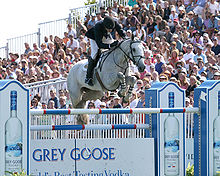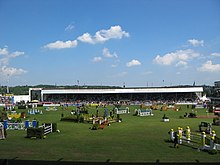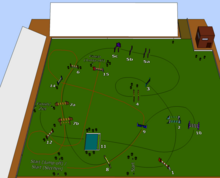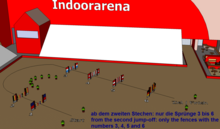Jumping competition
In addition to the style jumping test and the horse jumping test , a jumping competition is one of three types of tests in show jumping . It can be carried out according to various straightening procedures. Depending on the straightening process, the result is based on errors, time or a combination of both. Several jumping competitions (or other equestrian competitions, depending on the announcement) together form a horse show .
Straightening procedure A
In judging procedure A (International: Table A), mistakes in a jumping competition are sanctioned with penalty points. The result of the jumping competition then depends on the number of penalty points and the time required. Most of the jumping competitions are held in a form of judging procedure A.
The following basic international rules apply to the award of penalty points in judicial procedure A:
- the dropping of a rod or other corresponding part of the obstacle ( shedding ): 4 penalties
- Walking the horse into the moat or stepping on the white band behind the moat: 4 penalty points
- first refusal of the horse ( disobedience ): 4 penalty points
- Exceeding the permitted time: 1 penalty point for every four seconds or part thereof
- Second disobedience, fall of the rider and / or the horse, exceeding the maximum time, riding the obstacles in the wrong order or against the specified direction of the jump: the participant is eliminated
Different rules sometimes apply to national tournaments. The following deviations from the international regulations can be found at German national tournaments:
- the first disobedience is scored with 4 penalty points
- the second disobedience results in 8 penalty points
- the third disobedience leads to the departure of the participant
- up to 2017, exceeding the permitted time was rated differently (0.25 penalty points per commenced second of exceeding the time limit)
Jumping competition according to mistakes and time
Error-time jumping competitions consist of a one-time round over a set tournament course. The participants will be placed according to the number of penalty points scored, in the event of a tie, according to the time required. Thus, the participant with the fewest penalty points and the least time is the winner of the test.
Jumping competition with jump-off (normal round according to mistakes and time)
Jumping competitions with jump-off consist of a normal round and a jump-off. Both will be held (according to this announcement) in the style of a jumping competition according to mistakes and time. All participants who have achieved the same, lowest number of errors (usually zero errors) in normal circulation, will compete again in the jump-off. This takes place over a fixed, shortened course. The winner is the participant with the fewest penalty points and the least time needed in the jump-off. If only one participant achieves the lowest number of mistakes in the normal round, the jump-off is not applicable (this participant is then the winner of the test).
Jumping competition after mistakes, not against time
These jumping competitions consist of a one-time round over a set tournament course made up of obstacles . The participants are placed according to the number of penalty points scored, regardless of the time required. Thus, the participant or participants with the fewest penalty points is the winner of the test.
Jumping competition with jump-off (normal circulation not against time)
Jumping competitions with jump-off consist of a normal round and a jump-off. With this type of competition, the normal round is held in the style of a jumping competition after mistakes, not against time. All participants who have achieved the same, lowest number of errors (usually zero errors) in normal circulation, will compete again in the jump-off. This takes place over a fixed, shortened course. The winner is the participant with the fewest penalty points and the least time needed in the jump-off. If only one participant achieves the lowest number of mistakes in the normal round, the jump-off is not applicable (this participant is then the winner of the test). The most famous test that is advertised according to these regulations is the Hickstead Derby.
Show jumping competition with winning round
Jumping competitions with a winning round consist of a normal round and a second round similar to the jump-off (winning round). Both are held in the style of a jumping competition according to mistakes and time. 25 percent of the participants, but in any case all those who did not make any mistakes, start again in the winning round. This takes place over a fixed, shortened course. All participants in the winning round will be reset to zero error points before it begins. The winner is the participant with the fewest penalty points and the least time required in the winning round.
Until 2008, it was also possible for show jumping competitions with a winning round that, according to the regulations, the participants take the penalty points achieved in the normal round into the winning round.
Jumping competition with two rounds
Jumping competitions with two rounds consist of a first and a second round. The individual rounds are held in the style of a jumping competition according to mistakes and time or in the style of a jumping competition according to mistakes, not against time. Depending on the tender, either all participants or a specified number of participants reach the second round. This can be played over the same or a different course than in the first round. All participants in the second round take the penalty points achieved in the first round with them. The winner is the participant with the fewest penalty points and the least time required in the winning round.
Jumping competition with two rounds and jump-off
A jumping competition with two rounds and jump-off takes place in the same way as a jumping competition with two rounds (without jump-off). After the two rounds, however, there is still a jump-off for errors and time. This takes place over a fixed, shortened course. The winner is the participant with the fewest penalty points and the least time needed in the jump-off. If only one participant reaches the lowest number of mistakes after the first two rounds, the jump-off is not applicable (this participant is then the winner of the test). This announcement is used for national prices .
Two-phase jumping competition
All participants in a two-phase jumping competition start in a course that is advertised according to mistakes and time, just like in a jumping competition. If the rider receives penalty points during this first phase, the test is over for him. He is placed according to the penalty points he has achieved and the time required. Should a participant survive this first phase without penalty points, the time for the second phase starts running immediately. In this second phase, the participant has to master another (different) course in the style of a jumping competition according to mistakes and time. The winner is the participant with the fewest penalty points and the least time needed in the second phase.
Jumping competition with immediate jump-off
This jumping competition is largely identical to the two-phase jumping competition. However, the jump-off (identical to the second phase) does not begin immediately with crossing the finish line of the normal round (identical to the first phase), but only when the judges have approved it. The winner is the participant with the fewest penalty points and the least time needed in the jump-off.
Group jumping test
Group jumping competitions consist of a group stage and a winning round. Before the start of the examination, the participants are divided into groups (usually four or five participants per group). Each group is carried out according to the rules of an (independent) jumping competition according to mistakes and time. The winner of each group moves on to the subsequent winning round. In addition, the regulations can stipulate that a certain number of participants also qualify as lucky losers for the winning round. These are the best of the participants who did not qualify for the winning round (in terms of penalty points and time). The winning round takes place over a fixed, shortened course. All participants in the winning round will be reset to zero error points before it begins. The winner is the participant with the fewest penalty points and the least time required in the winning round.
This type of test leads to an exciting test process (after a few riders already the first decisions), but is not perceived by many participants as particularly fair (some participants with penalty points reach the winning round, but some participants are without mistakes from particularly strong groups not entitled to participate in the winning round).
Knock-out jumping competition
Knock-out jumping competitions (in short: knockout jumping, see also general: knockout system ) are special jumping competitions according to leveling procedure A. Two participants compete in two identical (mostly mirror-inverted ) courses at the same time . The participant with the fewest penalty points and the least amount of time is the winner in this part of the test and moves on to the next round. This system will be continued until the winner of the test according to these regulations is determined in a final round.
Knock-out competitions can alternatively by Scoring Method C are discharged.
Straightening procedure C
In judging procedure C (International: Table C), mistakes in a jumping competition are sanctioned with penalty seconds. The result of the jumping competition is then based on the time required plus the penalty seconds.
The following basic international rules apply to the award of penalty points in judicial procedure C:
- the throwing off of a rod or other associated part of an obstacle ( dropping ): 4 seconds
- Walking the horse into the moat or stepping on the white band behind the moat: 4 seconds
- First refusal of the horse ( disobedience ): without consequences (punishes itself over time), as far as obstacle has to be rebuilt through disobedience and has to be jumped again, 6 seconds are added to the time
- there is no permitted time
- Second disobedience, fall of the rider and / or the horse, exceeding the maximum time, riding the obstacles in the wrong order or against the specified direction of the jump: the participant is eliminated.
Time jumping test
Time jumping competitions consist of a round over a fixed tournament course, which is carried out according to the regulations of judging procedure C. The winner is the participant who, after adding the penalty seconds, needed the least amount of time for the round.
Jumping competitions with jump-off according to the alignment method C
Jumping competition with jump-off, the normal round of which is carried out according to judging procedure A, can also be carried out with a jump-off according to judging procedure C. In this case, all participants who have reached the same, lowest number of errors (usually zero errors) in normal circulation, will compete again in the jump-off. This takes place over a fixed, shortened course. The winner is the participant who, after adding up the penalty seconds, required the least amount of time for the jump-off course. In jump-offs after judging procedure C, throws are punished with three (instead of four) penalty seconds.
Relay jumping competition
Relay jumping competitions are jumping competitions according to the standard procedure C, in which several teams of two or three take part (all teams must consist of the same number of riders). It is ridden over a course in the style of a time jumping test. As soon as the first rider crosses the starting line, time begins to run. The next participant may only start in the (same) course as soon as the previous starter has crossed the finish line. The time for a team is stopped as soon as the last rider of the team has finished his course. The winner is the team that, after adding the penalty seconds, needed the least amount of time for the round.
Elective jumping competition
An elective jumping competition is a time jumping competition in which, however, the order in which the jumps must be overcome is not specified. The participant must cross the start and finish lines in the given direction. The direction in which the jumps are skipped is not specified. Participants who have not yet overcome a jump after crossing the finish line will be disqualified. The winner is the participant who, after adding the penalty seconds, needed the least amount of time for the round.
Jumping competitions according to special regulations
Jumping competitions according to special regulations take place on the basis of basic regulations that are identical to judging procedure A. These are jumping competitions with one normal round and three or four jump-offs. In most cases, very high obstacles are overcome here.
Power jumping
Thickness jumping tests are based on a basic set of rules that is identical to the leveling procedure A. These are jumping competitions with one normal round and three or four jump-offs. Power jumps are often referred to as self-service jumps in German-speaking countries.
Power jumps begin with a normal round, which is carried out in the style of a jumping competition after mistakes, not against time (judging procedure A). At the end of the normal circuit there is a wall made of individual, easily movable parts. In international competitions this is usually around 1.70 meters high.
If more than one participant is in first place with the same penalty point after the normal round, a jump-off will then take place. Before the first jump-off, the course is shortened so that it only consists of a "normal" obstacle (usually a triple bar ) and the wall. From now on this will be increased from round to round. If after the first jump-off there is more than one participant in first place with the same penalty point, a second jump-off will take place. In the same case, after the second jump-off, there is a third jump-off. In the event that only one participant is in the lead after a jump-off, this participant is the winner of the test.
After the third jump-off, both the judges' panel and the participants can determine that the test is ended. In that case there would be multiple winners. If a fourth jump-off should be carried out (more than four jump-offs are not permitted), this will be carried out in the same way as the previous jump-offs. After this jump-off, all participants who are in the lead with the same penalty points will be declared winners. Like the normal round, all jump-offs take place in the style of a jumping competition after mistakes, not against time.
In the post-war decades, power jumps were often carried out as "cannon jumps" in an attempt to set new height records. Among other things, the still valid indoor high jumping record of 2.35 meters ( Franke Sloothaak , 1991) dates from this time. Couples specially trained for this type of exam.
Barrier jumping test (Six Bar)
The regulations of a barrier jumping test are identical to those of a power jumping test. Instead of a wall, however, a series of six steep jumps is overcome, the height remains the same or increases from jump to jump (the latter is the more common variant). In the normal round and in the first jump-off, all six jumps are overcome, the first two jumps are often separated from the remaining four (see graphic). From the second jump-off, only the last four jumps of the course are overcome.
"Masters" jumping competitions
The FEI grants the (international) tournament organizer the opportunity to create their own tests within the framework of the FEI regulations. For example, the World Cup tournaments in Helsinki , London and Mechelen hold jumping competitions known as Masters. This involves a normal course, but the regulations are identical to those of the power jumping test.
Lucky jumping
A time is specified for lucky jumping tests (normally between 60 and 90 seconds, 45 seconds for tournaments in the hall). The aim is to overcome the obstacles as often as possible during this time. The participant receives two points for an obstacle overcome without errors, one point for an error. After the set time has elapsed, the participant has to jump another obstacle, but no points are calculated for this. The time is measured until hoisting after the last jump. The winner is the participant with the highest number of points achieved; in the event of a tie, the fastest time decides.
Point jumping test
A point jumping test consists of a one-time round over a fixed tournament course over six, eight or ten jumps. Every jump in this course has a certain value (jump one: one point), the value of the jumps increases by one point with each jump. If a rider overcomes a jump without errors, the respective number of points of the jump is counted for him. If there is a drop , the participant does not receive any points for this jump. The first disobedience is not punished as in judging procedure C (only over time). For the rest (for example with regard to the time) the regulations of the judging procedure A are applied. The winner is the participant with the most points and the least time required.
Point jumping competitions can also be announced with a joker. In this case, a joker jump can be used instead of the last jump on the course. This jump is more difficult than the other jumps on the course, but it also brings double the number of points of the last jump. If the joker is released, this double number of points will be deducted from the points achieved so far.
Hunt for points
The individual obstacles in the "hunt for points" are assessed and marked (depending on the difficulty) with points between 10 and 100. A time (between 45 and 90 seconds) is set within which all obstacles can be jumped as often as desired in any order and direction. Each obstacle is rated a maximum of twice. If there is a release at a jump, this obstacle may no longer be jumped. If a rider overcomes a jump without errors, the respective number of points of the jump is counted for him. If there is a drop , the participant does not receive any points for this jump. There is also a joker jump in the “hunt for points”. This brings 200 points if overcome without errors, but also a deduction of 200 points if it is thrown. After the specified time has elapsed, the participant must cross the finish line, only then will the time be stopped. The winner is the participant with the highest number of points and the least time required after crossing the finish line.
Derby exams
Derbies are special jumping competitions with natural jumps and terrain obstacles (walls, depressions, ricks with ditches). They can be held both as jumping competitions with jump-offs and as time jumping competitions. More on this can be found in the article Derby (equestrian sport) .
Individual evidence
- ↑ Question-and-answer catalog of the German Equestrian Association: Style jumping ( Memento from October 3, 2009 in the Internet Archive )
- ↑ FEI regulations part 1 "The Jumping Event" ( page no longer available , search in web archives ) Info: The link was automatically marked as defective. Please check the link according to the instructions and then remove this notice. (PDF; 1.4 MB), Article 236 - Table A
- ↑ Special LPO 2018 - News in the course: General - time errors . In: St. Georg . January 2018, p. 71 .
- ↑ FEI Regulations Part 1 “The Jumping Event”, Article 238.2.1 - Competitions against the clock
- ↑ a b FEI regulations part 1 "The Jumping Event", Article 238.2.2 - Competitions against the clock with jump off (see also Article 245 ff.)
- ↑ FEI Regulations Part 1 "The Jumping Event", Article 238.1 - Competitions not against the clock
- ↑ FEI regulations part 1 "The Jumping Event", Article 238.1.2 - Competitions not against the clock with jump off (see also Article 245 ff.)
- ^ FEI regulations part 1 "The Jumping Event", Article 276.2 - Competitions against the clock with winning round
- ↑ FEI regulations part 1 "The Jumping Event", former Article 276.3 - Competitions against the clock with winning round (winning round: penalties carried forward)
- ↑ FEI regulations part 1 "The Jumping Event", Article 273.1, 273.2, 273.3.3 - Competitions over two rounds (no jump off)
- ↑ FEI regulations part 1 "The Jumping Event", Article 273.1, 273.2, 273.3.1 or 273.3.2 - Competitions over two rounds (with jump off)
- ↑ FEI Regulations Part 1 “The Jumping Event”, Article 274 - Competitions in two phases
- ↑ FEI regulations part 1 "The Jumping Event", Article 238.2.2 in conjunction with 245.3 - Competitions with jump off (immediately)
- ↑ FEI Regulations Part 1 “The Jumping Event”, Article 275 - Competitions in groups with winning round
- ↑ FEI regulations part 1 "The Jumping Event", Article 272 - Knock-Out-Competition
- ↑ FEI Regulations Part 1 “The Jumping Event”, Article 239 - Table C
- ↑ FEI Regulations Part 1 “The Jumping Event”, Article 263 - Speed and Handiness Competition
- ↑ FEI regulations part 1 "The Jumping Event", Article 268.2 in conjunction with Article 2681 - Normal Relay Competition
- ↑ FEI regulations part 1 "The Jumping Event", Article 271 - Take-your-own-line competition
- ↑ Newspaper article "It goes high: Power jumping in the Westfalenhallen" from March 28, 2007, accessed on June 22, 2009
- ↑ FEI regulations part 1 “The Jumping Event”, Article 262.2 in conjunction with Article 262.1 - Puissance
- ↑ Kirchhoff also fails on the world record , November 26, 2007
- ↑ FEI Regulations Part 1 "The Jumping Event", Article 262.3 in conjunction with Article 262.1 - Six Bar
- ↑ FEI regulations part 1 "The Jumping Event", Article 260.2 in conjunction with Article 262.1
- ↑ FEI regulations part 1 “The Jumping Event”, Article 267 - Hit-and-hurry-Competition
- ^ FEI regulations part 1 "The Jumping Event", Article 269 - Accumulator Competition
- ↑ FEI regulations part 1 "The Jumping Event", Article 270 - Top Score Competition
- ↑ FEI Regulations Part 1 “The Jumping Event”, Article 277 - Derby










